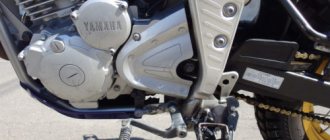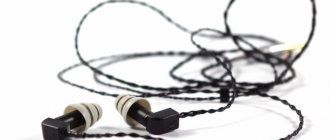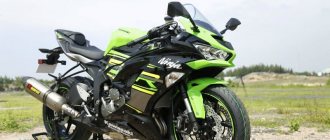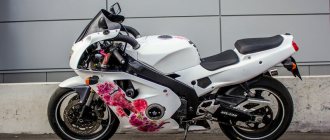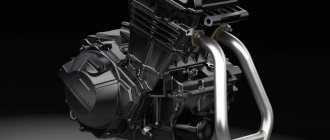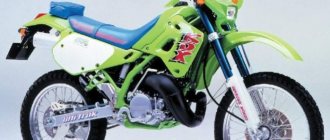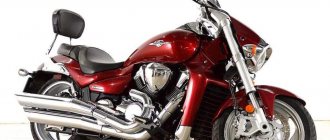| Kawasaki Estrella (1992-1999) | Kawasaki Estrella RS (1995-2006) | Kawasaki Estrella Custom (1996-2006) |
| Kawasaki Estrella RS Custom (1996-1999) | Kawasaki Estrella Custom (Limited Edition) 2002 | Kawasaki Estrella RS (Limited Edition) 2002-2006 |
| Kawasaki Estrella (2007-2017) |
Retro classic model Kawasaki Estrella 250
was first introduced in 1992. The concept of the model was simple - to present to the market a retro classic motorcycle in the British style, which should be simple, reliable and used for leisurely trips around the city. Despite the abundance of modern “plastic” motorcycle models and a rather limited circle of fans of retro classics, the Kawasaki Estrella 250 has found a large army of fans, being produced for more than 25 years. Only in mid-2021 did Kawasaki announce the discontinuation of the model, releasing the last limited edition of this motorcycle.
The Kawasaki Estrella 250 was aimed only at the domestic Japanese market, but some models were sold in Germany and some other European countries over the years.
The model is distinguished by a simple steel frame, a 1-cylinder air 2-valve engine, disc or drum brakes (depending on the version), simple suspension in the form of a conventional telescopic fork and a double shock absorber, and a low “dry” weight of around 140 kg. Since 2007, the Kawasaki Estrella 250 has received fuel injection and a digital instrument panel.
The main competitors of the Kawasaki Estrella 250 in the class:
- Honda FTR 223 / Honda CB223S
- Suzuki TU250X Volty
- Yamaha SRV 250 / Yamaha Bronco 225 (ST225)
Brief history of the model
- 1992 - start of production and sales of Kawasaki Estrella 250.
Model
: Kawasaki Estrella (Japan).
Factory designation
: BJ250-B1.
- 1993 - no significant changes.
Model
: Kawasaki Estrella (Japan).
Factory designation
: BJ250-B2.
- 1994 - no significant changes.
Model
: Kawasaki Estrella (Japan).
Factory designation
: BJ250-B3.
- 1995 - appearance of the RS modification.
Model
: Kawasaki Estrella, Kawasaki Estrella RS (Japan).
Factory designation
: BJ250-B4, BJ250-C1, BJ250-C1A.
- 1996 - appearance of Custom and RS Custom modifications. The regular version is not offered.
Model
: Kawasaki Estrella Custom, Kawasaki Estrella RS Custom (Japan).
Factory designation
: BJ250-D1, BJ250-E1.
- 1997 - regular version available again + regular RS version available.
Model
: Kawasaki Estrella, Kawasaki Estrella Custom, Kawasaki Estrella RS, Kawasaki Estrella RS Custom (Japan).
Factory designation
: BJ250-B5, BJ250-D2, BJ250-C3, BJ250-E2.
- 1998 - no significant changes.
Model
: Kawasaki Estrella, Kawasaki Estrella Custom, Kawasaki Estrella RS, Kawasaki Estrella RS Custom (Japan).
Factory designation
: BJ250-B6, BJ250-D3, BJ250-C4, BJ250-E3.
- 1999 - no significant changes.
Model
: Kawasaki Estrella, Kawasaki Estrella Custom, Kawasaki Estrella RS, Kawasaki Estrella RS Custom (Japan).
Factory designation
: BJ250-B7, BJ250-B7A, BJ250-D4, BJ250-D4A, BJ250-C5, BJ250-C5A, BJ250-E4, BJ250-E4A.
- 2000 - Only Custom and RS trims offered.
Model
: Kawasaki Estrella Custom, Kawasaki Estrella RS (Japan).
Factory designation
: BJ250-D5, BJ250-C6.
- 2001 - no significant changes.
Model
: Kawasaki Estrella Custom, Kawasaki Estrella RS (Japan).
Factory designation
: BJ250-D6, BJ250-C7.
- 2002 - in addition to the main versions of Custom and RS, limited editions of these modifications are available (Limited Edition).
Model
: Kawasaki Estrella Custom, Kawasaki Estrella Custom Limited Edition, Kawasaki Estrella RS, Kawasaki Estrella RS Limited Edition (Japan).
Factory designation
: BJ250-D7, BJ250-H1, BJ250-C8, BJ250-G1.
- 2003 - Only Custom, RS and RS Limited Edition versions offered.
Model
: Kawasaki Estrella Custom, Kawasaki Estrella RS, Kawasaki Estrella RS Limited Edition (Japan).
Factory designation
: BJ250-D8, BJ250-C9, BJ250-G2.
- 2004 - no significant changes.
Model
: Kawasaki Estrella Custom, Kawasaki Estrella RS, Kawasaki Estrella RS Limited Edition (Japan).
Factory designation
: BJ250-D9, BJ250-C10, BJ250-G3.
- 2005 - no significant changes.
Model
: Kawasaki Estrella Custom, Kawasaki Estrella RS, Kawasaki Estrella RS Limited Edition (Japan).
Factory designation
: BJ250-D10, BJ250-C11, BJ250-G4.
- 2006 - no significant changes.
Model
: Kawasaki Estrella Custom, Kawasaki Estrella RS, Kawasaki Estrella RS Limited Edition (Japan).
Factory designation
: BJ250D6F, BJ250C6F, BJ250G6F.
- 2007 - all versions of the model are discontinued, giving way to the regular Kawasaki Estrella, which is the second generation of the model of the same name, produced from 1992 to 1999.
Model
: Kawasaki Estrella (Japan).
Factory designation
: BJ250J7F.
- 2008 - no significant changes.
Model
: Kawasaki Estrella (Japan).
Factory designation
: BJ250J8F.
- 2009 - no significant changes.
Model
: Kawasaki Estrella (Japan).
Factory designation
: BJ250J9F.
- 2011 - no significant changes.
Model
: Kawasaki Estrella (Japan).
Factory designation
: BJ250JBF.
- 2012 - no significant changes.
Model
: Kawasaki Estrella (Japan).
Factory designation
: BJ250JCF.
- 2013 - no significant changes.
Model
: Kawasaki Estrella (Japan).
Factory designation
: BJ250JDF.
- 2014 - Due to updated environmental regulations, the engine and exhaust system of the Kawasaki Estrella undergoes slight changes, resulting in a slight reduction in maximum power and torque.
Model
: Kawasaki Estrella (Japan).
Factory designation
: BJ250K.
- 2015 - no significant changes.
Model
: Kawasaki Estrella (Japan).
Factory designation
: BJ250L.
- 2016 - no significant changes.
Model
: Kawasaki Estrella (Japan).
- 2017 is the last year of release.
Model
: Kawasaki Estrella (Japan).
Factory designation
: BJ250A.
History of changes
The bike, of course, went through several stages in its development, which was difficult not to do during a twenty-five-year career:
- 1992 – start of production;
- 1995 – RS modification appeared;
- 1996 – the Custom version was created;
- 2007 – the second generation comes out, but versions except the regular one disappear;
- 2017 is the last year of production.
This motorcycle will forever remain in the memory of people who respect retro classics in motorcycle construction. Kawasaki's Estrella embodies the best of these bikes.
Specifications
Technical characteristics of Kawasaki Estrella 250:
| Model | Kawasaki Estrella 250 |
| Motorcycle type | retro classic |
| Year of issue | 1992-2017 |
| Frame | steel half-duplex |
| engine's type | 1-cylinder, 4-stroke |
| Working volume | 249 cm³ |
| Bore/Stroke | 66.0 x 73.0 mm |
| Compression ratio | 9.0:1 |
| Cooling | air |
| Number of valves per cylinder | SOHC, 2 valves |
| Fuel supply system | carburetor, 1x — Estrella (1992-2006) injector, 1x — Estrella (2007-2017) |
| Ignition type | transistor |
| Maximum power | 20 hp (15 kW) at 7500 rpm - Estrella (1992-2006) 20 hp (15 kW) at 7800 rpm - Estrella (2007-2013) 18 hp (13 kW) at 7500 rpm - Estrella (2014-2017) |
| Maximum torque | 20 Nm (2.1 kgf*m) at 6000 rpm - Estrella (1992-2006) 20 Nm (2.1 kgf*m) at 6500 rpm - Estrella (2007-2013) 18 Nm (1.8 kgf*m) at 5500 rpm - Estrella (2014-2017) |
| Clutch | Multi-disc in oil bath, cable drive |
| Transmission | 5-speed |
| type of drive | chain |
| Front tire size | 90/90-18 51P |
| Rear tire size | 110/90-17 60P |
| Front brakes | 1 disc 300 mm (drum – Estrella Custom, Estrella RS Custom), 1-piston caliper (2-piston – Estrella 2007-2017) |
| Rear brakes | 1 disc, 1-piston caliper (160 mm drum - Estrella Custom, Estrella RS Custom, Estrella 2007-2017) |
| Front suspension | 39 mm telescopic fork, travel - 120 mm |
| Rear suspension | pendulum with two shock absorbers, stroke - 95 mm |
| Dimensions (L x W x H) | 2075 x 775 x 1035 mm |
| Wheelbase | 1400 mm |
| Seat height | 735 mm |
| Minimum ground clearance (clearance) | 170 mm |
| Maximum speed | 121 km/h |
| Gas tank capacity | 14.0 l – Estrella (1992-2006) 13.0 l – Estrella (2007-2017) |
| Motorcycle weight (curb) | 161 kg |
For whom
The Kawasaki Estrella motorcycle is perfect for those who want to use the bike not for high speeds, but for leisurely trips. Such walks can be pleasant in their own way, and you don’t want to go on them on a chopper or, especially, on a sports motorcycle.
Of course, a large, solid cruiser, one of those often called classics, may also be well suited for such leisurely trips. But here, who likes what more... Estrella is an excellent choice for connoisseurs of retro classics in the English style. In addition, unlike massive cruisers, this bike at least looks more compact.
Reviews
Reviews of Kawasaki Estrella 250:
Expand Collapse
Appearance - everything is clear here. For lovers of the classics. The engine is the same as the TR250. The sound is low, beautiful)
I don’t know what they write in the specs about the mass, but it seemed lighter in feel than the ebrik on which I studied. The steering wheel is light - just like a bicycle! Personally, I (183/93) felt frankly cramped on it. In any case, on this fashionable single seat, but my wife wanted exactly this and it’s comfortable for her)
The ignition switch is located on the left under the tank. The steering column is locked separately. You can also use the same key to open the lock for attaching the helmet. But, unfortunately, there was no glove compartment.
Another disadvantage is that the choke has only 2 positions. Actually on and off. Fully extendable and latched, no intermediate positions. And there is no fuel gauge. But I was pleased with the presence of a central footrest.
This modification has disc brakes at the front and rear, but I haven’t tried them yet on the stiff tires. I’ll write back next season) But most likely they are more than enough for such a machine.
I recently became the proud owner of a Kawasaki Estrella. I didn’t delve into the technical characteristics of this device at all, I just figured that I could easily handle it, and that’s all, I mainly paid attention to the appearance (not in the sense that there is no rust, but most importantly - the silhouette - so that there is a normal motorcycle) . That’s how I bought it, and after riding it I was convinced of my good choice - an excellent motorcycle, holds the road, it’s not hard on the butt, it’s easy to control, the weight is about 150 kg. The maximum speed is probably 110 km/h (120 on the speedometer), but I haven’t driven more than 100, to be honest, I don’t know how to drive fast and don’t want to, I’m in no hurry. The gas tank is 14 liters, and I refuel after 280 km (still a reserve remains). Pulls well at low end. The headlight is bright. In general - I like it! Especially good for beginners, or “dummies”, like me. There may be some downsides, but they don't bother me. Moreover, I've been waiting for it for so long!
Epigraph: Never buy a Kawasaki Estrella I’ll share some knowledge, maybe it will be useful to someone. I will try to present everything in the form of instructions for inspecting a motorcycle before purchasing. And I’ll tell you a little about the experience of operating this rare animal.
Part one: "Lyrical". You don’t have to read it. I won’t give the characteristics of the motorcycle, there are a great many of them on all sorts of different sites.
I’ll say the main thing: - Eats little; — It rushes sluggishly; — Girls don’t stick to motorcycles; The motorcycle is designed for a person of average height and average weight - a typical Japanese (the device is not suitable for our heroes). The bike has the WOW factor, but more on that later.
Models of motorcycles with a volume of 250 cm3 on our market are represented mainly by Chinese disposable devices, for beginners and for those who have little money, but really want to ride. Estrella, somewhat, from another opera. Yes, it is 250 cm3, but it is Japanese. Because of this, from the point of view of the average buyer, the price is inadequate. In order to please buyers, the bulk of Kawasaki Estrella motorcycles are imported from Japan with auction ratings of “3” points and below. Because the buyer does not want to pay more. _ What does it mean? - This means that the motorcycles are all “tired”. And in order for the motorcycle to please you, you will need to invest a certain amount of money. Sometimes this amount reaches half the cost of the motorcycle. But maybe you'll get lucky)))
However, let's get to the point.
Part two: “Technical”.
You have decided that this is exactly the motorcycle that you need. Monitor different sites, find a suitable ad, come and take a look.
What should you watch first? First of all, before you go anywhere, find out the frame number and look at the history of the motorcycle in Japan. The peculiarity is that in Japan Estrella is a bicycle. It is not registered and can have an amazing life path. The color of the motorcycle may change many times, along with auction estimates. This is all not in favor of the motorcycle. But the decision is yours to make.
You have decided. Yes, you want to see the motorcycle live. And now you are standing in front of a motorcycle. Here it is worth remembering the golden rule: the motorcycle must be chosen as the “fifth point”. Sit on the motorcycle, feel it. You still have a chance to change your mind.
Liked? Then take the head at “8” and remove the timing chain cover.
But it could also be like this
The peculiarity of the small-capacity BJ250 engine is that after 30,000 km, the timing chain must be changed. Otherwise the engine begins to die. He dies smoothly and unnoticeably. And then, suddenly, the “motor doctor” tells you that you need to order a bunch of spare parts from Japan. And this is extremely expensive. Look at the timing chain - you are surprised or happy, wondering how long it will take to change it. By the way, the timing chain on the Estrella is exactly the same as on the Yamaha TTR250. But a chain from a catalog for Yamaha is twice as cheap as a chain for Kava from the same catalogue.
After inspecting the timing chain, if everything is good, inspect the fork legs. Like any other motorcycle, the presence of “potholes” on the stays means replacing the stay, and this, again, is a lot of money. My fork lasted almost 30,000 km, after which it began to cry. The oil seals and a can of oil cost me $30. But my friend had to change his pen. A new fork blade costs about $500. I’ll say right away that it’s difficult to find anything at a disassembly, the model is rare.
let's continue...
After the timing chain and fork legs, inspect the rubber. The tire size on Estrella is not popular; this size is delivered to order. As a rule, they set: Rear 120/90-17, 120/80-17; Front 100/90-18 That is, going to choose where is better and cheaper is not an option. If the tires are old, then this is an additional cost. Bargain, or better yet, refuse to buy before it’s too late.
I would recommend choosing a motorcycle with disc brakes. Finding brake pads for disc brakes is not a problem. I use two or three sets per season. Fortunately, almost every motorcycle store has them. One of the most common brake pads for Estrella with disc brakes is Ferodo FDB314. But I don't like them.
If you have read this far and, despite my persuasion to abandon this idea, have decided to become an estrel fisher, then let’s continue
Part Three: Operation
The motorcycle was purchased for active use. It is used almost every day from March to October in any weather.
Since the motorcycle was received almost new, we can make some information on the resource of spare parts. I drove more than 30,000 km on it, and here’s what was replaced: — a set of clutch discs with springs (it started slipping); — a chain with stars (I decided that it was time to change it and changed it); — front fork seals (oil leaked at 30,000 km); — rear shock absorbers (died after 20,000 km); — Timing chain (as expected, replaced after 30,000 km). — fuel tap membrane (fuel tap leaked); — clutch cable (broken); — Throttle cables (replaced just in case); — battery Characteristics: Capacity, Ah: 8.6. Dimensions, mm: 150x87x93. Starting current, A: 120. Polarity: straight (+ -)
Regular consumables: 1) It is recommended to change the oil every 3000 km. Filter Hiflofiltro HF123. Oil Motul 5100, 2 liters; 2) brake pads. The frequency of replacement depends on where, how and how much you drive; 3) Chain lubrication; 4) clean the carburetor once a season. When cleaning the carburetor, it is advisable to have a repair kit. I take this one: MCI TM CAB-K4 5) Spark plug NGK DR9EA (NGK DR9EVX)
Kawasaki Estrella - “A motorcycle for an egoist.” It is not comfortable for two people to ride on it. There are several reasons for this, including the position of the second number and the power of the horse. If you are looking for a motorcycle for a beautiful ride through Europe, then the Kawasaki Estrella is not your choice.
The motorcycle fits seamlessly into narrow city streets and suburban secondary roads. He is uncomfortable on expressways and wide avenues. Comfortable speed 90 km/h. You can leave the traffic light ahead of everyone else, but not for long. Soon some Priora will catch up with you and shamelessly overtake you.
Part four: “Final”. The motorcycle is very noticeable. People pay attention, children look at them, wave, it’s very touching))) But the biggest advantage of this motorcycle is its maintainability. Everything can be removed and unscrewed without any strain. The device is simple and reliable like an AK-47. No special tool required. What fans of Soviet motorcycles really like. Since repairing this Japanese is a “rewarding task.”
But I warn you one last time: Never buy a Kawasaki Estrella - why? You will either be disappointed in him or fall in love. You will most likely be disappointed. My observations show that most happy owners get rid of the motorcycle after a year or two. They grow out of it. I want something more “driving” and perky. And the Kawasaki Estrella is a calm, smooth motorcycle that does not provoke you to prove something to anyone. The motorcycle is designed for a calm, relaxed ride. You won’t be able to “beat” on it. The motorcycle, as they say, is a vegetable. Although there are exceptions
- why? You will either be disappointed in him or fall in love. You will most likely be disappointed. My observations show that most happy owners get rid of the motorcycle after a year or two. They grow out of it. I want something more “driving” and perky. And the Kawasaki Estrella is a calm, smooth motorcycle that does not provoke you to prove something to anyone. The motorcycle is designed for a calm, relaxed ride. You won’t be able to “beat” on it. The motorcycle, as they say, is a vegetable. Although there are exceptions
But this motorcycle was created for contemplation and peace.
I warned you.
Kawasaki Estrella review
The Kawasaki Estrella 250 is a long-lived motorcycle. It's no joke - it is still on the assembly line, and the production of this model began back in 1992. Small details like paint and seats have changed from year to year, but it is still the same motorcycle, the popularity of which has ensured it such a long life.


